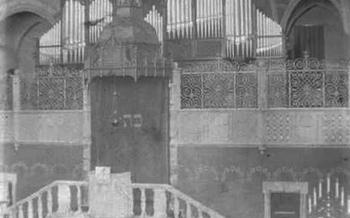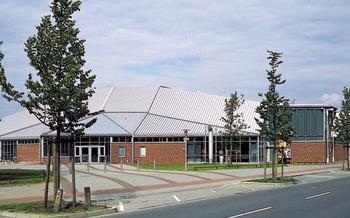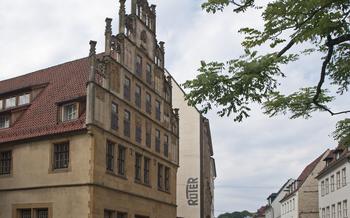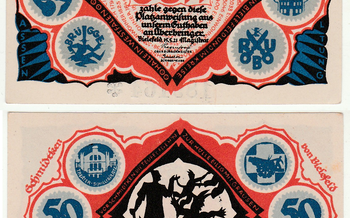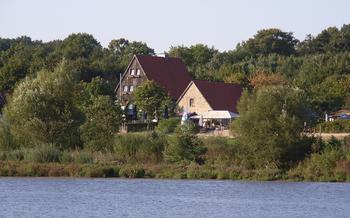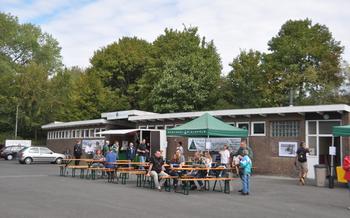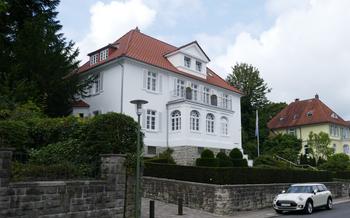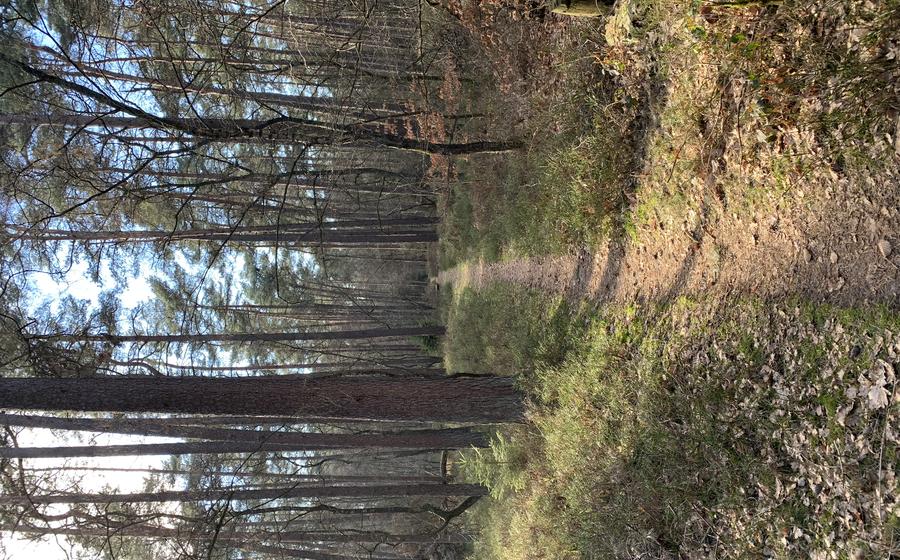
Teutoburg Forest
- A Walk Through History
- Hermann the Cheruscan
- The Natural Beauty of the Forest
- Personal Anecdote
- Detmold: A Charming Town
- Externsteine Rock Formations
- Theoretical: The Geological and Historical Significance of the Externsteine
- Practical: Exploring the Rock Formations, Climbing Opportunities, and Guided Tours
- Anecdote: A Personal Experience Witnessing the Sunrise from the Externsteine
- Horn-Bad Meinberg Spa Town
- Oerlinghausen: A Village of Craftsmanship
- Bielefeld: City of Art and Culture
- Sparrenberg Castle
- Shopping in Bielefeld
- Local Cuisine
- Practical Information
- Insider Tip
- Insider Tip: Uncovering the Hidden Gem of the Teutoburg Forest
A Walk Through History
The Teutoburg Forest is a region of historical significance, as it was the site of a decisive battle in 9 AD between the Roman army and a coalition of Germanic tribes led by Arminius, a Cheruscan chieftain. This battle, known as the Battle of the Teutoburg Forest, resulted in the defeat of the Romans and marked a turning point in the history of the Roman Empire.
To delve deeper into the historical significance of the forest, travelers can visit the Kalkriese Museum, which offers a detailed account of the battle and its aftermath. The museum features exhibits on Roman military tactics, Germanic weapons, and the impact of the battle on the development of Europe. Another must-visit is the Varusschlacht im Osnabrücker Land Museum, which provides an interactive experience, allowing visitors to explore the battlefield through virtual reality and augmented reality displays.
During my visit to the ancient battlefields, I was struck by the palpable sense of history that permeated the air. As I stood on the ground where the battle had taken place, I couldn't help but imagine the clash of swords and the roar of the warriors that had echoed through the forest over two thousand years ago.
Hermann the Cheruscan
Hermann, better known as Arminius, was a legendary figure who played a crucial role in the Battle of the Teutoburg Forest. Born into the Cherusci tribe, he received a Roman education and became fluent in Latin. This unique upbringing allowed him to understand Roman tactics and strategies, which he used to his advantage in the battle.
Hermann's leadership and tactical brilliance were instrumental in the Germanic victory. He forged alliances with neighboring tribes, united them against the Romans, and lured the Roman legions into an ambush in the dense forests. His intimate knowledge of the terrain, combined with his strategic prowess, allowed the Germanic forces to inflict a devastating defeat on the Roman army.
The victory at the Teutoburg Forest was a turning point in Roman history. It not only halted the Roman expansion into Germania but also shattered the myth of Roman invincibility. Hermann's triumph became a symbol of Germanic resistance and pride, and his name continues to be revered as a national hero in Germany.
In Detmold, visitors can pay homage to Hermann at the Hermannsdenkmal, an imposing monument that stands atop the Teutberg hill. This colossal statue, erected in 1875, depicts Hermann raising his sword in defiance, symbolizing the triumph of the Germanic tribes over the Roman Empire. The monument offers panoramic views of the surrounding countryside and is a popular destination for history enthusiasts and nature lovers alike.
The Natural Beauty of the Forest
The Teutoburg Forest is a haven for nature enthusiasts, boasting a diverse array of flora and fauna. Its ancient woodlands, vibrant meadows, and sparkling streams create a picturesque landscape that invites exploration. Whether you prefer hiking, cycling, or simply taking a leisurely stroll, the forest offers a multitude of trails and paths to suit every preference.
Among the highlights of the forest are its stunning viewpoints, which offer panoramic vistas of the surrounding countryside. The Velmerstot, a 468-meter-high hill, is one of the most popular viewpoints, offering breathtaking views of the forest and the distant peaks of the Harz Mountains. Other notable viewpoints include the Hermannsdenkmal, a towering monument that commemorates the Battle of the Teutoburg Forest, and the Externsteine, a series of striking rock formations that have become a symbol of the region.
The forest is also home to a rich variety of wildlife. Deer, wild boar, and foxes are commonly spotted, and the forest is also home to a variety of birds, including woodpeckers, owls, and hawks. With a little luck, you may even catch a glimpse of a red squirrel or a marten darting through the trees.
Personal Anecdote
On a crisp autumn morning, I embarked on a solo hike through the Teutoburg Forest. As I wandered along the winding trails, the sound of my footsteps crunching on the fallen leaves filled the air. The forest was alive with the sounds of birdsong, and the sun's rays filtered through the trees, casting a golden glow on the landscape.
As I reached a clearing, I came across a small herd of deer grazing peacefully in the meadow. I stopped to watch them for a while, marveling at their elegance and grace. They seemed completely oblivious to my presence, and I felt a sense of tranquility and awe as I observed them in their natural habitat.
Continuing on my hike, I stumbled upon a hidden waterfall nestled among the trees. The sound of the cascading water was mesmerizing, and I sat down on a nearby rock to enjoy the peaceful atmosphere. As I listened to the water flowing and the birds singing, I felt a sense of connection to the natural world that is so often lacking in our modern lives.
The Teutoburg Forest is a place of wonder and beauty, where visitors can escape the hustle and bustle of everyday life and reconnect with nature. Whether you are looking for a challenging hike, a leisurely bike ride, or simply a quiet place to relax and appreciate the beauty of the natural world, the Teutoburg Forest has something to offer everyone.
Detmold: A Charming Town
Detmold, a captivating town nestled in the heart of the Teutoburg Forest, boasts a rich history and cultural heritage. Founded in the 13th century, Detmold served as the capital of the Principality of Lippe until 191Its legacy is evident in the town's well-preserved historic center, featuring charming half-timbered houses, cobblestone streets, and stately buildings.
Practical Information
Begin your exploration of Detmold at the Detmold Castle, an imposing Renaissance-style structure that once served as the residence of the Lippe princes. Today, the castle houses the Lippisches Landesmuseum, which showcases a fascinating collection of regional history, art, and culture.
A short walk from the castle, you'll find the Arminiuspark, a serene park dedicated to the legendary Germanic chieftain who led the Cherusci tribe to victory against the Roman legions in the Battle of the Teutoburg Forest. The park features a bronze statue of Arminius, as well as beautiful gardens, walking paths, and a playground for children.
Anecdote
During my visit to Detmold, I had the opportunity to attend the annual Altstadtfest, a traditional German festival that takes place in the town's historic center. The festival was a delightful celebration of German culture, with food stalls offering local delicacies, live music performances, and traditional dancing. I particularly enjoyed trying the regional specialty, Lippischer Pickert, a delicious potato pancake served with applesauce and bacon.
Externsteine Rock Formations
Theoretical: The Geological and Historical Significance of the Externsteine
The Externsteine rock formations are a unique geological phenomenon, consisting of several massive sandstone pillars that rise dramatically from the surrounding forest. Their formation is attributed to the erosion of a sandstone ridge over millions of years. These natural wonders have been a source of fascination and speculation for centuries, and their distinctive shapes have inspired numerous legends and myths.
In addition to their geological significance, the Externsteine also hold historical and cultural importance. The site has been used as a religious and ritualistic center since prehistoric times, and evidence of human activity dating back to the Stone Age has been found in the area. The rock formations also played a role in the Germanic-Roman wars, as they served as a strategic lookout point for the Germanic tribes.
Practical: Exploring the Rock Formations, Climbing Opportunities, and Guided Tours
Visitors to the Externsteine can explore the site on foot, following a network of well-marked trails that wind through the forest and around the rock formations. There are also opportunities for rock climbing, with routes ranging from beginner to expert levels. Several guided tours are available, providing insights into the geology, history, and legends associated with the site.
Anecdote: A Personal Experience Witnessing the Sunrise from the Externsteine
I had the opportunity to visit the Externsteine at sunrise on a clear summer morning. As the first rays of sunlight illuminated the rock formations, they cast a warm glow on the surrounding forest, creating a magical atmosphere. The silence was broken only by the sound of birdsong, and I felt a sense of awe as I stood there, contemplating the beauty and majesty of nature.
Horn-Bad Meinberg Spa Town
Horn-Bad Meinberg is a charming spa town nestled within the Teutoburg Forest, renowned for its healing thermal springs. These springs have been attracting visitors for centuries, seeking relief from various ailments. The town boasts several thermal baths and spa facilities, offering a range of treatments, from traditional bathing rituals to modern wellness therapies.
Practical Tips
-
Immerse yourself in the rejuvenating waters of the thermal baths, known for their therapeutic properties. Relax and let the warm, mineral-rich water soothe your body and mind.
-
Indulge in a variety of spa treatments, including massages, facials, and body wraps, designed to promote relaxation and well-being.
-
Explore the beautiful spa gardens, offering tranquil spaces to unwind and soak up the natural surroundings.
Anecdote
During my visit to Horn-Bad Meinberg, I had the opportunity to experience the healing power of the thermal waters firsthand. I immersed myself in the warm, inviting waters of the thermal bath, feeling a sense of deep relaxation wash over me. As I floated effortlessly, I could feel the tension and stress melt away, replaced by a sense of tranquility and well-being.
Oerlinghausen: A Village of Craftsmanship
Oerlinghausen, a picturesque village nestled within the Teutoburg Forest, holds a deep-rooted tradition of craftsmanship that has been passed down through generations. This vibrant heritage is evident in the numerous workshops, galleries, and shops that line the charming streets, showcasing an array of exquisite handmade goods.
Visiting Oerlinghausen is like stepping into a living museum of traditional artistry. The village is home to skilled craftsmen who specialize in a diverse range of crafts, including pottery, woodworking, glassblowing, and metalworking. Their workshops are a testament to their dedication and expertise, as visitors can witness firsthand the intricate processes involved in creating these beautiful objects.
Exploring the galleries in Oerlinghausen is a delightful experience, as one can admire the finished products of these talented artisans. From delicate porcelain figurines to intricately carved wooden sculptures, each piece is a testament to the skill and creativity of the local craftsmen. Whether you're looking for a unique souvenir or simply appreciate the beauty of traditional craftsmanship, Oerlinghausen is a treasure trove of handmade wonders.
Anecdote:
During my visit to Oerlinghausen, I had the opportunity to meet a passionate potter named Herr Schmidt. His small workshop was a haven of creativity, filled with the earthy aroma of clay and the gentle whirring of his potter's wheel. As he skillfully molded a lump of clay into a graceful vase, Herr Schmidt shared stories about his lifelong journey in ceramics. His infectious enthusiasm and the evident love for his craft left a lasting impression on me.
Bielefeld: City of Art and Culture
Bielefeld, the vibrant city in the heart of North Rhine-Westphalia, is a treasure trove of cultural experiences. From world-class museums to captivating theaters and art galleries, Bielefeld offers an eclectic mix of artistic expression.
At the forefront of the city's cultural scene is the Kunsthalle Bielefeld, an internationally renowned art museum that houses a diverse collection of modern and contemporary artworks. From paintings and sculptures to installations and photography, the Kunsthalle offers a thought-provoking journey through the world of contemporary art.
For those who prefer the performing arts, the Theater Bielefeld is a must-visit. This acclaimed theater presents a wide range of productions, from classic plays to modern dramas, musicals, and dance performances. With its state-of-the-art facilities and talented ensemble, the Theater Bielefeld guarantees an unforgettable evening of entertainment.
History buffs will delight in exploring the Historisches Museum Bielefeld, which delves into the rich past of the city and the surrounding region. Through interactive exhibits, artifacts, and multimedia presentations, the museum brings to life the fascinating stories of Bielefeld's transformation from a medieval trading town to a modern industrial center.
In addition to these prominent institutions, Bielefeld boasts a thriving independent arts scene. Small galleries, artist-run spaces, and cultural initiatives showcase the works of local and emerging artists, providing a platform for experimentation and innovation. Whether you're an art enthusiast or simply looking for a unique cultural experience, Bielefeld has something to offer everyone.
Sparrenberg Castle
Theoretical:
Sparrenberg Castle is a magnificent historical landmark that proudly stands atop the Sparrenberg Hill, overlooking the city of Bielefeld. This imposing fortress dates back to the 13th century and boasts a rich and captivating history. Its sturdy walls and towers have witnessed numerous battles, sieges, and changes in ownership throughout the centuries.
Practical:
Prepare to be awed as you explore the castle grounds, which offer a glimpse into medieval life. Discover the intricate architecture, marvel at the well-preserved fortifications, and soak in the breathtaking panoramic views of Bielefeld and its surrounding landscapes. Throughout the year, the castle hosts a variety of exciting events, including medieval festivals, concerts, and exhibitions, offering a chance to immerse yourself in its vibrant history.
Anecdote:
I vividly recall my first visit to Sparrenberg Castle. As I stepped through its ancient gates, I felt an overwhelming sense of awe and intrigue. The castle's grandeur and the stories that seemed to emanate from every stone captivated me. I spent hours wandering through its chambers, admiring the intricate carvings and imagining the lives of those who had once resided within its walls. The highlight of my visit was participating in a medieval festival, where I donned a costume, feasted on traditional delicacies, and watched spellbinding performances that transported me back in time.
Shopping in Bielefeld
Bielefeld, a Shopper's Paradise
Bielefeld has earned a reputation as a premier shopping destination in Germany, attracting visitors with its diverse range of shopping options. From bustling pedestrian zones to modern shopping malls and charming boutiques, Bielefeld offers an unforgettable shopping experience for every taste.
Pedestrian Zone: A Shopper's Haven
The pedestrian zone in the heart of Bielefeld is a shopper's paradise, lined with an array of retail stores, boutiques, and department stores. Here, you'll find everything from international fashion brands to local artisanal crafts, ensuring a unique and diverse shopping experience.
Shopping Malls: Convenience and Variety
For those seeking convenience and variety under one roof, Bielefeld offers several modern shopping malls. From the expansive Bielefeld Arcaden, with its over 100 shops, to the cozy Loom, each mall offers a unique shopping environment catering to different tastes and preferences.
Local Boutiques: Unique Finds and Treasures
Venturing off the beaten path, Bielefeld's charming side streets are home to a treasure trove of local boutiques. These independent shops offer a curated selection of unique items, from handcrafted jewelry and vintage clothing to local art and homeware. Whether you're looking for a one-of-a-kind souvenir or a special gift, these boutiques are sure to delight.
Insider Tip: Discovering Hidden Gems
For those seeking a truly unique shopping experience, Bielefeld offers a hidden gem known as the "Hinterhöfe" (backyards). Tucked away behind the main shopping streets, these charming courtyards are home to a variety of independent shops, galleries, and cafés. Here, you'll find an eclectic mix of vintage finds, handmade crafts, and local delicacies, making the Hinterhöfe a must-visit for any discerning shopper.
Local Cuisine
The Teutoburg Forest region boasts a rich culinary tradition, blending local ingredients with influences from neighboring regions. Westphalian ham, a dry-cured ham, is a regional specialty, renowned for its smoky and slightly salty flavor. It is often served with boiled potatoes and sauerkraut, a dish that embodies the hearty nature of German cuisine. Pumpernickel bread, a dark, dense bread made from rye flour, is another regional staple. Its slightly bitter taste complements the robust flavors of Westphalian ham and other regional dishes.
During the spring season, the region celebrates the arrival of Spargel (white asparagus), a highly prized delicacy. Harvested locally, Spargel is meticulously peeled and prepared, often served with melted butter, hollandaise sauce, and boiled potatoes. Its sweet, nutty flavor and tender texture make it a culinary highlight of the region.
Beyond these signature dishes, the Teutoburg Forest region offers a diverse range of culinary experiences. Traditional German restaurants serve hearty dishes like Schnitzel (breaded cutlet), Bratwurst (grilled sausage), and Kartoffelpuffer (potato pancakes), all paired with refreshing local beers. For a taste of international cuisine, Bielefeld offers a variety of restaurants serving Italian, Greek, and Asian dishes, catering to diverse culinary preferences.
Personal Anecdote:
During my visit to the Teutoburg Forest, I had the opportunity to savor the local cuisine at a traditional German restaurant. The atmosphere was warm and inviting, with wooden beams and checkered tablecloths. I started with a hearty bowl of Westphalian pea soup, followed by a plate of Schnitzel with mushroom sauce and boiled potatoes. The flavors were rich and satisfying, a true testament to the culinary heritage of the region. I ended my meal with a slice of homemade apple strudel, the perfect sweet ending to a delicious meal.
Practical Information
Transportation
Bielefeld is well-connected by public transportation, with regular train and bus services to major cities in Germany. The city also has a well-developed local transportation system, making it easy to get around.
Accommodation
Bielefeld offers a variety of accommodation options to suit all budgets, from budget-friendly hostels to luxurious hotels. There are also plenty of charming guesthouses and bed-and-breakfasts for those who prefer a more personalized experience.
Tourist Resources
The Bielefeld Tourist Information Center is a great place to start your trip planning. The center provides maps, brochures, and other resources to help you make the most of your stay. You can also book tours and activities through the tourist information center.
Insider Tip
Hidden Gem: Kunsthallen Kloster Gravenhorst
For art enthusiasts, a visit to the Kunsthallen Kloster Gravenhorst is a must. This hidden gem is located in a former monastery and features a collection of modern and contemporary art. The Kunsthallen Kloster Gravenhorst is a great place to escape the hustle and bustle of the city and immerse yourself in art.
Insider Tip: Uncovering the Hidden Gem of the Teutoburg Forest
Amidst the vast expanse of the Teutoburg Forest, there lies a hidden gem that remains untouched by the throngs of tourists. Nestled deep within the heart of the woods, this secret spot offers a tranquil retreat for those seeking solace and communion with nature.
The journey to this hidden gem begins with a leisurely hike along a winding forest path. As you venture deeper into the woods, the sounds of civilization gradually fade away, replaced by the gentle rustling of leaves and the melodious chirping of birds.
After a while, you will stumble upon a clearing, where a small, idyllic lake shimmers in the dappled sunlight. The water is crystal clear, reflecting the vibrant hues of the surrounding forest. A wooden dock juts out into the lake, inviting you to sit down and soak in the serene atmosphere.
As you sit there, gazing out at the tranquil waters, a sense of peace washes over you. The worries and stresses of everyday life melt away, leaving you feeling refreshed and rejuvenated. The hidden gem of the Teutoburg Forest has worked its magic, transporting you to a realm of tranquility and serenity.
